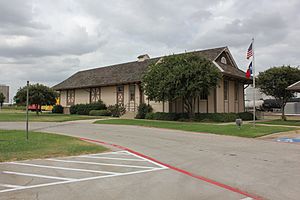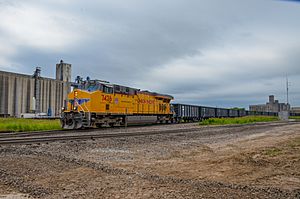Saginaw, Texas facts for kids
Quick facts for kids
Saginaw, Texas
|
|
|---|---|
| City of Saginaw | |

The Saginaw Chamber of Commerce in a former train station
|
|
| Motto(s):
Train and Grain
|
|

Location of Saginaw in Tarrant County, Texas
|
|
| Country | |
| State | |
| County | |
| Government | |
| • Type | Council-Manager |
| Area | |
| • Total | 7.66 sq mi (19.82 km2) |
| • Land | 7.65 sq mi (19.82 km2) |
| • Water | 0.00 sq mi (0.01 km2) |
| Elevation | 732 ft (223 m) |
| Population
(2020)
|
|
| • Total | 23,890 |
| • Density | 3,118.8/sq mi (1,205.3/km2) |
| Time zone | UTC-6 (CST) |
| • Summer (DST) | UTC-5 (CDT) |
| ZIP codes |
76131, 76179
|
| Area code(s) | 817 |
| FIPS code | 48-64112 |
| GNIS feature ID | 2411754 |
| Website | City of Saginaw, Texas |
Saginaw is a city located in Tarrant County, Texas, in the United States. It's like a neighbor to the bigger city of Fort Worth. In 2020, about 23,890 people lived there. Saginaw is a special kind of city that can make its own local rules, which is called a Home Rule city.
Contents
History of Saginaw
The city of Saginaw got its name in 1882. A man named Jarvis J. Green chose the name. He used to live and work on Saginaw Street in Pontiac, Michigan. The name "Saginaw" comes from the Ojibwe language. It means "to flow out." It is also the name of a river, a bay, and another city in Michigan.
Geography of Saginaw
Saginaw is located in Texas. The United States Census Bureau says the city covers about 7.5 square miles (19.4 square kilometers). All of this area is land.
People Living in Saginaw
The number of people living in Saginaw has grown a lot over the years.
| Historical population | |||
|---|---|---|---|
| Census | Pop. | %± | |
| 1950 | 561 | — | |
| 1960 | 1,001 | 78.4% | |
| 1970 | 2,382 | 138.0% | |
| 1980 | 5,736 | 140.8% | |
| 1990 | 8,551 | 49.1% | |
| 2000 | 12,374 | 44.7% | |
| 2010 | 19,806 | 60.1% | |
| 2020 | 23,890 | 20.6% | |
| U.S. Decennial Census | |||
As of the 2020 United States census, there were 23,890 people living in Saginaw. These people lived in 8,343 households, and 6,292 of these were families.
Most people in Saginaw are White (about 54.5%). Other groups include Black or African American (6.9%), Asian (3.4%), and people of Hispanic or Latino background (29.9%). There are also people from other races and those who are multiracial.
Economy and Jobs in Saginaw
Saginaw has two main railroad lines that run through the city. These lines are used by large companies like Union Pacific and BNSF. Because of these railroads, Saginaw has many heavy industries. This means there are a lot of factories and businesses that make big things.
Saginaw is known for its "Train & Grain" history. This is because of the railroads and two large flour mills in the city. You can see huge grain elevators from far away. They are a big part of the city's center.
Top Employers in Saginaw
Here are some of the biggest employers in Saginaw:
| # | Employer | # of Employees | Percentage of Total |
|---|---|---|---|
| 1 | Eagle Mountain-Saginaw ISD | 2,541 | 30% |
| 2 | CTI Beanmaker&Chefco Foods | 440 | 5% |
| 3 | Ventura Foods | 398 | 5% |
| 4 | Walmart Supercenter #5316 | 393 | 5% |
| 5 | Trinity North Amer. Freight Car | 370 | 4% |
| 6 | Anchor Fabrication Corp. | 320 | 4% |
| 7 | BANA Incorporated | 247 | 3% |
| 8 | Texas Army National Guard | 245 | 3% |
| 9 | Ranger Fire Inc. | 200 | 2% |
| 10 | Russo Corporation | 200 | 2% |
Education in Saginaw
Saginaw does not have its own colleges or universities. However, it is close to Fort Worth and the wider Dallas/Fort Worth area. This area has many colleges and universities, including the Tarrant County College system.
The schools in Saginaw are part of the Eagle Mountain-Saginaw Independent School District. There are several high schools in this district:
- Boswell High School
- Saginaw High School
- Chisholm Trail High School
- Eagle Mountain High School
- Watson High School/Alternative Discipline Center (this school helps students who might be at risk)
Notable People from Saginaw
Many interesting people have come from Saginaw, including:
- Brec Bassinger, an actress
- Janet Gunn, an actress
- Brad Hawpe, a baseball player in Major League Baseball (MLB)
- Angela Stanford, a professional golfer on the Ladies Professional Golf Association (LPGA) tour
- Kirk Watson, a politician
See also
 In Spanish: Saginaw (Texas) para niños
In Spanish: Saginaw (Texas) para niños


